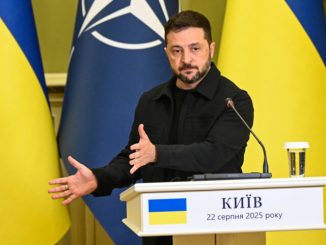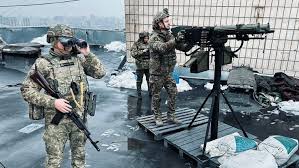
In this photo released by Russian Foreign Ministry Press Service, Russian Foreign Minister Sergey Lavrov, right, and North Korea’s leader Kim Jong Un shake hands during their meeting in Wonsan, North Korea, on Saturday, July 12, 2025. (Russian Foreign Ministry Press Service via AP)
Published July 13, 2025
In a striking show of unity against Western influence in East Asia, Russian Foreign Minister Sergey Lavrov concluded a high-profile visit to North Korea, delivering a stern warning to the United States, South Korea, and Japan. Moscow cautioned the three allies against forming a trilateral security alliance targeting Pyongyang—emphasizing that any such move would also be viewed as a threat to Russia itself. Lavrov’s visit, which included meetings with Kim Jong Un and appearances at military and resort sites, signals a deepening of the Russia–North Korea axis at a time when tensions on the Korean Peninsula are escalating. With military cooperation, mutual defense agreements, and even tourism on the table, the visit marks a turning point in regional power dynamics—drawing clear lines between U.S.-led alliances and the emerging Russia–North Korea partnership.
🚨 Russia’s Strong Message via Lavrov’s Visit to North Korea
Who & When:
Russian Foreign Minister Sergey Lavrov visited North Korea from July 11–13, 2025, making strategic stops in Pyongyang and Wonsan.
Core Message:
Lavrov delivered a clear warning to the U.S., South Korea, and Japan—urging them against forming a trilateral “security alliance” that would be “directed against … North Korea and, of course, Russia”
Backdrop:
-
The U.S.–South Korea–Japan trilateral drills have grown in intensity, highlighted by recent joint air exercises near the peninsula, including deployments of U.S. nuclear-capable bombers
-
North Korea views these as aggressive rehearsals, reinforcing its narrative of self‑defense and supporting its nuclear development .
🔗 Moscow–Pyongyang: A Strategic Deepening
Alliance Posture:
-
Kim Jong Un and Lavrov highlighted that Moscow and Pyongyang share “identical views on all strategic issues in conformity with the level of alliance”
-
This builds on the 18 June 2024 “Comprehensive Strategic Partnership Treaty,” which took effect in December 2024, pledging mutual defense
Military & Material Support:
-
North Korea’s contribution includes troops, ammunition (12 million rounds of 152 mm shells!), and possibly even engineers and sappers to Russia’s Kursk region
-
These deployments bolster Russia’s Ukraine campaign while potentially enhancing North Korea’s own capabilities.
🏖️ Tourism Boost Amid Military Pacts
https://www.youtube.com/live/AvIl6AczJpw?si=StXyK8XaCZFJSJ_v
 Resulting Effects:
Resulting Effects:
Lavrov’s high-profile visit to North Korea—and the clear message it carried—has already triggered a series of geopolitical ripples across Northeast Asia and beyond. The deepening Russia–North Korea alliance, now fortified by a mutual defense pact and public warnings to the U.S., South Korea, and Japan, is shifting the regional balance of power in ways that cannot be ignored.
1. Elevated Military Threat in the Indo-Pacific:
With Russia essentially backing North Korea’s military posture, including its controversial nuclear ambitions, the risk of conflict escalation on the Korean Peninsula has grown. The alliance provides Pyongyang with added confidence—and possibly more sophisticated military technology from Moscow—making North Korea an even more unpredictable threat.
2. Pressure on the U.S.–Korea–Japan Trilateral Cooperation:
Lavrov’s warning aims to fracture or slow down the formation of a U.S.–South Korea–Japan security triangle. However, it may have the opposite effect: galvanizing closer military coordination among the three democratic nations as a necessary counterweight to the growing authoritarian bloc in the region.
3. North Korea Gains Diplomatic Legitimacy:
Through Russia’s open embrace, Kim Jong Un is shaking off some of the diplomatic isolation imposed by years of sanctions and missile tests. This newfound support allows Pyongyang to re-enter international dialogues—not as a rogue state, but as a formal ally of a global power with veto authority at the U.N. Security Council.
4. Strategic Leverage for Moscow in Ukraine & Beyond:
By drawing North Korea deeper into its geopolitical orbit, Moscow secures a reliable source of munitions, manpower, and symbolic solidarity for its ongoing war in Ukraine. The partnership also acts as a wedge against U.S. influence in the Pacific, creating a new front in Russia’s broader confrontation with the West.
5. Potential for Sanctions Evasion and Resource Exchange:
Economic cooperation, including tourism and trade, may give North Korea new avenues to bypass international sanctions—especially with Russia acting as an economic enabler. From energy supplies to food, and possibly arms-for-tech exchanges, both regimes benefit materially from this relationship despite U.N. restrictions.
In short, the Russia–North Korea axis is no longer theoretical—it’s operational. The West now faces a dual-front challenge: containing Russia’s aggression in Europe while confronting its expanding footprint in East Asia.
 Bottom Line:
Bottom Line:
Sergey Lavrov’s visit to North Korea was far more than diplomatic theater—it marked a concrete step in solidifying an authoritarian alliance that challenges U.S. interests on two major fronts: Eastern Europe and Northeast Asia. Russia’s open warning to Washington, Seoul, and Tokyo against forming a regional security bloc underscores how Moscow and Pyongyang now view any U.S.-led cooperation as a direct threat to their survival and strategic ambitions.
This partnership empowers Kim Jong Un with both political legitimacy and material support, while giving Vladimir Putin a new lever to undermine Western influence far from Ukraine’s battlefields. As Russia and North Korea deepen their cooperation—from military pacts and arms exchanges to tourism and propaganda—the world is witnessing the reemergence of a hardened axis, united not by shared prosperity or democratic values, but by mutual defiance against Western pressure.
For the United States and its allies, this evolving threat demands more than rhetoric—it calls for firm coordination, upgraded deterrence capabilities, and a renewed commitment to defending freedom in the Indo-Pacific.





Be the first to comment